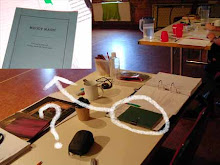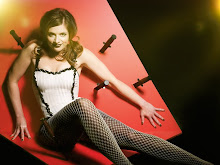
As the cast and crew assembled for the first morning in the Malthouse foyer Michael Kantor’s welcome speech drew attention to the fact that this was only one of the project’s ‘first mornings.’ When prompted director Chris Kohn revealed that the project had begun back in 2005. Across a series of development periods there had already been a series of ‘first mornings’ before this one. And of course, that’s only in relation to "Goodbye Vaudeville Charlie Mudd." When you take into account the more than half a dozen collaborations between Lally Katz and Chris Kohn, the number of ‘first mornings’ builds into many, many more. We so often think of plays as discrete works, and in some ways they are, but in other ways they can be seen in the context of multiple collaborations between artists over many years.
The morning was spent reading the play. How to start a rehearsal process can be a difficult question; a new play, a new group of performers and creatives, with various existing (or non-existing) relationships. Reading the play can be as much about breaking the ice as it is about putting the play as whole at front and centre. Also, it allows everybody to be present and bear witness as the work begins. After this morning it is possible that all of the creatives won’t be in the room at the same time until the play is into dress rehearsal or even opening night.
After lunch it feels as though the creative work in rehearsal begins for real. Mark Jones, the composer and actor, leads the cast in learning the show’s first song. It’s a group choral number, which allows everybody to work together. Learning songs requires hard, detailed work, but sitting around a piano in a group to sing is a traditional joy that’s hard to resist. It’s work that allows the actors to hear each others’ voices, to work rhythmically together, to start to get in touch with each other. While the actors are singing as characters, and questions of character do emerge, their focus need not be as much on individual understandings of character as when they are rehearsing scenes.
Further, working on a song helps to prioritise the ‘forms’ of theatre at the heart of vaudeville. Before exploring the play about vaudeville, they are practising becoming ‘vaudevillians.’ The mood lightens, the group start being able to joke with each other and get to know each other’s creative energy. At the same time as the actors sing the rest of the group work on their respective responsibilities. Laptops come out and the team of designers continue to work, sneaking pieces of Chris’s time to ask a quick question or clarify a feeling they’ve been working with. Lally has loads of notes and ideas stemming from the reading already. A new script is generally a living document during a rehearsal period. As the text on the page is transformed into the spoken word nuances are continually being yielded up that writers will want to seize upon; advance or remove as it serves the play.
The group singing is broken up by a design presentation. Jonathon Oxlade [set and costume designer] and Chris talk about the visual design elements of the show. The fact that Jonathon is an illustrator as well as a set designer means that the sketches and materials he presents are especially close to what will eventually appear in the show. They are not merely functional design documents, so much as artworks in their own right. The actors feed off the presentation, inspired and excited by the clues the visual design elements present of the characters in Chris and Lally’s combined imaginations.
The morning was spent reading the play. How to start a rehearsal process can be a difficult question; a new play, a new group of performers and creatives, with various existing (or non-existing) relationships. Reading the play can be as much about breaking the ice as it is about putting the play as whole at front and centre. Also, it allows everybody to be present and bear witness as the work begins. After this morning it is possible that all of the creatives won’t be in the room at the same time until the play is into dress rehearsal or even opening night.
After lunch it feels as though the creative work in rehearsal begins for real. Mark Jones, the composer and actor, leads the cast in learning the show’s first song. It’s a group choral number, which allows everybody to work together. Learning songs requires hard, detailed work, but sitting around a piano in a group to sing is a traditional joy that’s hard to resist. It’s work that allows the actors to hear each others’ voices, to work rhythmically together, to start to get in touch with each other. While the actors are singing as characters, and questions of character do emerge, their focus need not be as much on individual understandings of character as when they are rehearsing scenes.
Further, working on a song helps to prioritise the ‘forms’ of theatre at the heart of vaudeville. Before exploring the play about vaudeville, they are practising becoming ‘vaudevillians.’ The mood lightens, the group start being able to joke with each other and get to know each other’s creative energy. At the same time as the actors sing the rest of the group work on their respective responsibilities. Laptops come out and the team of designers continue to work, sneaking pieces of Chris’s time to ask a quick question or clarify a feeling they’ve been working with. Lally has loads of notes and ideas stemming from the reading already. A new script is generally a living document during a rehearsal period. As the text on the page is transformed into the spoken word nuances are continually being yielded up that writers will want to seize upon; advance or remove as it serves the play.
The group singing is broken up by a design presentation. Jonathon Oxlade [set and costume designer] and Chris talk about the visual design elements of the show. The fact that Jonathon is an illustrator as well as a set designer means that the sketches and materials he presents are especially close to what will eventually appear in the show. They are not merely functional design documents, so much as artworks in their own right. The actors feed off the presentation, inspired and excited by the clues the visual design elements present of the characters in Chris and Lally’s combined imaginations.
It will be all I can do not to accidentally fill this site with ‘spoilers.’ Nevertheless, over the next couple of days I’ll try to get some time with Jonathon to ask him a question or two about his process.
The day in a word for Lally - thrilling
The day in a word for Chris- soup




bom bom! adorei esta pagina amassada! veja meu blog!
ReplyDelete